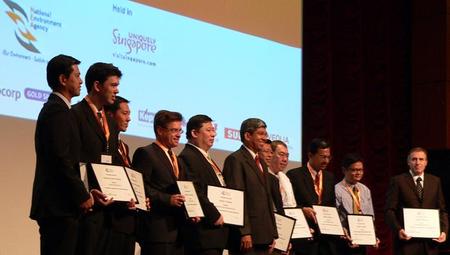by Mallika Naguran
Over the months since June 2007, Singapore’s food & beverage (F&B) companies have been busy looking into a whole new practice – cutting packaging waste – even as they continue to crank up the same line of products. They had signed a voluntary pact – the Singapore Packaging Agreement – with the National Environment Agency to review their environmental impacts and got down to action.
First up were 19 companies, then in 2008 there were 31 new ones joining in to make changes to packaging or processes to reduce waste at source. These include cutting down on the thickness, weight or dimensions of packaging materials, reusing and recycling packaging, and educating customers on waste minimisation. Ten companies were recognised for their achievements in reducing packaging waste by Singapore's Minister for the Environment and Water Resources Dr Yaacob Ibrahim (middle).The effort has paid off. Collectively, packaging usage was chopped down by 17% or 850 metric tons all-round. This saving translates to less waste dumped at landfills or burnt at incineration plants. It also means less energy being used in the first place to make those extra packaging and less use of resources in moving heavier or bulkier packaging to consumers, within the country or around the world.
Ten companies were recognised for their achievements in reducing packaging waste by Singapore's Minister for the Environment and Water Resources Dr Yaacob Ibrahim (middle).The effort has paid off. Collectively, packaging usage was chopped down by 17% or 850 metric tons all-round. This saving translates to less waste dumped at landfills or burnt at incineration plants. It also means less energy being used in the first place to make those extra packaging and less use of resources in moving heavier or bulkier packaging to consumers, within the country or around the world.
A laudable achievement considering that this initiative was largely industry-led. One association that pushed the agenda through was the Singapore Manufacturers’ Federation. Sunny Koh, chairman of the F&B industry group and deputy chairman of the Singapore Packaging Agreement Governing Board, revealed that apart from networking during CEO lunches, education was vital in getting companies involved and committed to the cause. “Through the sharing sessions, CEOs became aware that some waste reduction efforts would not require new capital outlay.”
Companies are motivated by cost savings in becoming greener, and this is not necessarily a bad thing, opines Sunny. “We first win companies over by appealing to bottom line savings; I tell CEOs that savings from wastage trimming will be greater than net profit.” The lunch sessions alone led to overwhelming success with 21 out of 31 attending companies signing up to become signatories on the spot or soon after.
Companies have access to government grants and the Food Innovation and Resource Centre housed in the Singapore Polytechnic to provide them with the necessary financial and consulting resource on minimising wastage. “The resource centre helps by providing spin up test or shelf life test of existing or new products while saving costs,” he explains. Sunny on saving waste.Apart from seeking elsewhere for help, companies can do well by looking inward, advises Sunny. “Increase wholesome and saleable area in the production floor like reducing substandard products is where cost savings can be had. Size reduction counts too. For example have potato chip foil bags pack in more chips and less nitrogen (needed to keep chips fresh).” He elaborates that with compact packaging, there are greater savings in freight cost (shipping more in one container), warehousing and delivery (charges are calculated by cubic metre).
Sunny on saving waste.Apart from seeking elsewhere for help, companies can do well by looking inward, advises Sunny. “Increase wholesome and saleable area in the production floor like reducing substandard products is where cost savings can be had. Size reduction counts too. For example have potato chip foil bags pack in more chips and less nitrogen (needed to keep chips fresh).” He elaborates that with compact packaging, there are greater savings in freight cost (shipping more in one container), warehousing and delivery (charges are calculated by cubic metre).
“There’s greater production output too as auto form, fill and seal machine capacity is calculated by metre per minute, hence the shorter bag will have higher quantities per minute,” he adds. Equipment maintenance is also important to factor out errors which can be costly in the long run.
Signatories of the Singapore Packaging Agreement are committed to: meet national packaging recycling targets, share data on materials consumed and waste reduced/recycled, bear environmental considerations, raise consumer awareness on waste reduction and develop sustainable markets for reused/recycled packaging materials.
The Singapore Packaging Agreement was developed by a taskforce that was co-chaired by NEA, the Packaging Council of Singapore and the Singapore Environment Council to help reduce waste over a 5-year period. Members of the taskforce include representatives from industry, government and NGOs.
Singapore 3R Packaging Awards
Ensuring that companies’ actions are not gone to waste, an award ceremony was held to recognise their achievements in reducing packaging waste.
Ten award recipients were honoured during the opening ceremony of the International Global Waste Symposium in Singapore on 3rd of November 2008, of which four were given distinction awards and they were Asia Pacific Breweries (Singapore) or APBS, Boncafe International, Kentucky Fried Chicken (KFC) and Tetra Pak Jurong.
APBS in June 2008 reduced the Tiger Quart bottle glass weight for domestic market from 520g to 500g, resulting in 79.8 tons per year of packaging material saved. KFC scaled down the size of its home delivery boxes and saw 17 tons of paper saved plus $21,000 in material cost.
Six merit awardees were Chinatown Food Corporation, F&N Coca-Cola (Singapore), McDonald’s Restaurant, Nestle Singapore, Subway Singapore and Sunfresh Singapore.
Chinatown Food of frozen roti prata fame reduced the thickness of its plastic packaging from 70 to 60 microns, translating to lowering of weight by 8.4 tons and 7% reduction in material cost that works out to savings of $35,000 yearly. F&N Coca-Cola made their aluminium drink cans and PET bottle lighter, reducing materials used, increasing energy consumption and saving the company up to $346,000 yearly.
Winners met varying degrees of these assessment criteria: packaging waste avoidance, recycling or reuse of packaging waste, consumer education, use of recyclable/recycled packaging material and reduction of other wastes.
Photos by Mallika Naguran.
Check out the rest of the signatory list here.